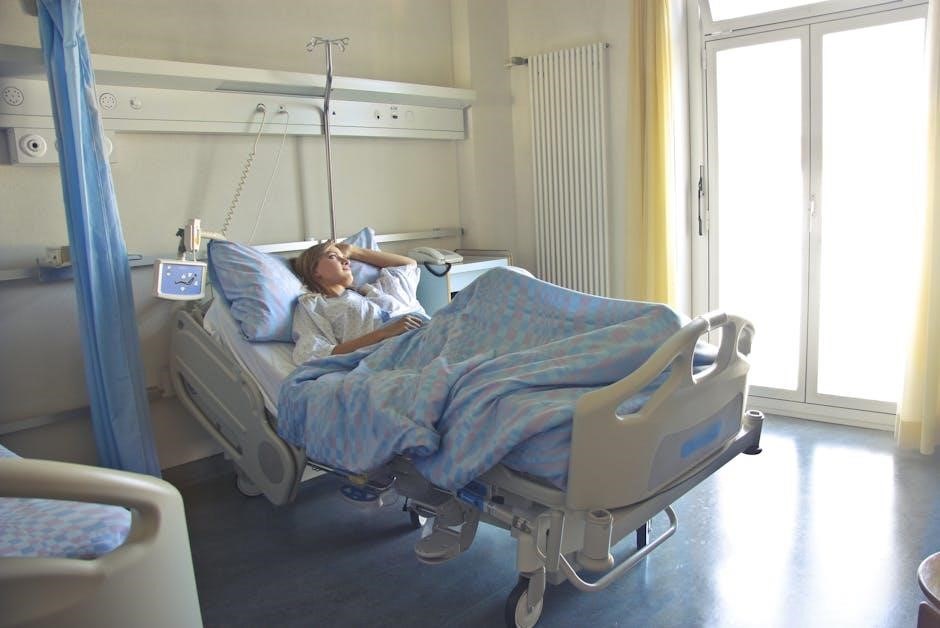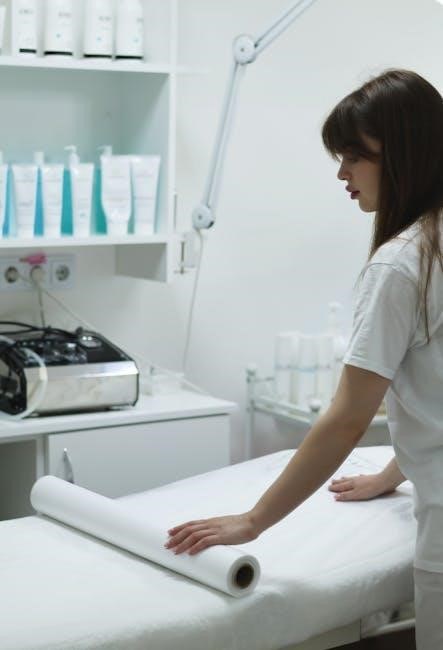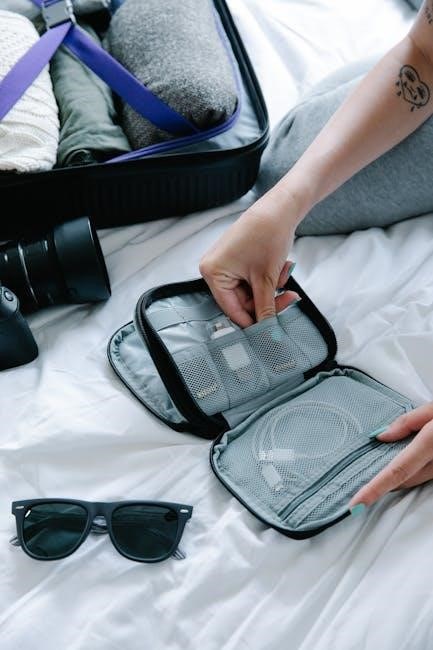Proper preparation is crucial for effective bed bug treatment. This chapter provides a detailed checklist to guide you through essential steps, ensuring the best results and the treatment’s success.
1.1. Importance of Proper Preparation
Proper preparation is vital for the success of bed bug treatment. It ensures that the treatment is effective, reduces the risk of re-infestation, and minimizes disruptions. Without adequate preparation, bed bugs may survive, leading to repeated treatments and increased costs. A well-structured checklist helps homeowners stay organized, addressing key tasks like washing bedding, vacuuming, and decluttering. This step is crucial for creating an environment where pesticides and other treatments can work optimally. Neglecting preparation often results in incomplete elimination and prolonged infestation issues.
1.2. Overview of the Checklist
A comprehensive checklist ensures all necessary steps are taken before treatment. It includes essential tasks like washing bedding, vacuuming, and decluttering. The checklist also covers laundry preparation, furniture inspection, and chemical treatment safety. By following it, homeowners can create an optimal environment for treatment success. This organized approach helps reduce stress and ensures no critical steps are missed. The checklist is a valuable tool for achieving long-term bed bug elimination and preventing future infestations.

Understanding Bed Bugs

Bed bugs are small, flat, nocturnal insects that feed on human blood. They hide in cracks and crevices, thriving in cluttered environments, making them challenging to eliminate.
2.1. Biology and Behavior of Bed Bugs
Bed bugs are small, flat, oval-shaped insects that feed on human and animal blood. Adults are about 4-5 mm long, reddish-brown, and have a distinctive odor. They thrive in warm environments and are nocturnal, feeding at night. Bed bugs hide in cracks, crevices, and under mattresses during the day. Their ability to survive for months without feeding makes them resilient. Understanding their biology and behavior is crucial for effective treatment, as it helps identify hiding spots and feeding patterns.
2;2. Signs of Bed Bug Infestation
Common signs of bed bug infestation include live bugs in various life stages, tiny white eggs, and shed skins. Reddish-brown spots or bloodstains on bedding indicate feeding activity. Bite marks on skin, often in a line or cluster, are another key indicator. A sweet, musty odor may also be present. Check for bugs in mattress seams, box springs, and behind headboards. Early detection is crucial for effective treatment, so regular inspections are recommended to identify infestations before they worsen.

Essential Preparation Steps
Key preparation involves washing bedding, vacuuming thoroughly, decluttering, and moving furniture away from walls. These steps ensure a conducive environment for effective bed bug treatment.
3.1. Washing and Drying Bedding
Wash all bedding, including sheets, pillowcases, and comforters, in hot water (at least 120°F) using a strong detergent. Dry everything on the highest heat setting for at least 20 minutes to ensure bed bugs and eggs are eliminated. Immediately seal clean items in plastic bags to prevent re-infestation. This step is critical before treatment, as it reduces the bed bug population and prepares the environment for pesticide application or other treatments.
3.2. Vacuuming and Cleaning
Thoroughly vacuum all surfaces, including mattresses, box springs, bed frames, carpets, and rugs, using a vacuum cleaner with a hose attachment. Pay special attention to cracks and crevices where bed bugs hide. Use a vacuum bag and dispose of it immediately after each use to prevent bugs from escaping. After vacuuming, clean all surfaces with a damp cloth and strong detergent to remove any remaining bed bug residues or eggs. This step helps reduce the bed bug population and prepares the area for treatment.
3.3. Decluttering and Organizing
Decluttering and organizing are essential steps in bed bug treatment preparation. Start by sorting items, keeping only what is necessary, and discarding or storing unused items in sealed bags or containers. Remove any unnecessary clutter from rooms, especially near beds and furniture, as bed bugs often hide in crowded areas. Organize remaining items neatly to prevent bed bugs from finding hiding spots. This step ensures that treatment is more effective and helps prevent re-infestation by reducing potential habitats for bed bugs.

Laundry and Fabric Preparation
Wash all clothes and bedding in hot water and dry on high heat to kill bed bugs and eggs. Store clean items in sealed bags to prevent re-infestation.
4.1. Washing Clothes and Linens
Washing clothes and linens is a critical step in bed bug treatment preparation. All bedding, including sheets, pillowcases, and comforters, should be washed in hot water (at least 120°F) to kill bed bugs and their eggs. Clothes that may have come into contact with bed bugs should also be laundered. Use a mild detergent and ensure items are completely dry before storing them in sealed plastic bags to prevent re-infestation. This step helps reduce the bed bug population and prepares your home for further treatment.
4.2. Drying on High Heat
Drying clothes and linens on high heat is essential for eliminating bed bugs and their eggs. After washing, place items in a dryer and set the temperature to the highest setting. Ensure items are dried for at least 20 minutes to ensure all bed bugs are killed. This step is particularly important for items that cannot be washed, such as stuffed animals or curtains, which should still be dried on high heat. Proper drying helps ensure the treatment’s effectiveness and prevents future infestations.
4.3. Storing Clean Items
After washing and drying, store clean items in sealed bags or airtight containers to prevent re-infestation. Use bed bug-proof bags or plastic bins with tight-fitting lids. Keep items off the floor and away from walls to reduce the risk of bed bugs re-entering. Label each bag or container with its contents and the date for easy identification. Avoid mixing clean items with those that may still be infested. Proper storage ensures your efforts remain effective and helps maintain a bed bug-free environment after treatment.

Furniture and Room Preparation
Move furniture 24 inches away from walls, remove items from counters, and ensure all areas are accessible for treatment. Thorough preparation enhances effectiveness and reach.
5.1. Stripping and Inspecting Beds
Strip all beds of sheets, covers, and pillows, and inspect mattresses and box springs for signs of bed bugs, such as live bugs, eggs, or dark spots. Remove any items stored under beds, as these can harbor bed bugs. Wash and dry bedding on high heat to kill any remaining bugs or eggs. Ensure mattresses are bare and accessible for treatment. This step is critical for ensuring the treatment reaches all areas where bed bugs may hide, improving its effectiveness and preventing re-infestation.
5.2. Moving Furniture Away from Walls
Move all furniture, including beds, dressers, and nightstands, at least 24 inches away from walls to ensure proper access for treatment. This allows technicians to inspect and treat all areas thoroughly. Keep floors clear of clutter to prevent bed bugs from hiding. Avoid pushing furniture back until treatment is complete. This step is essential for ensuring all potential hiding spots are addressed, improving the effectiveness of the treatment and reducing the risk of re-infestation. Proper spacing also helps in achieving comprehensive coverage during the process.
5.3. Removing Items from Counters
Clearing counters is essential for effective treatment. Remove all items from countertops, tables, and shelves to prevent bed bugs from hiding in clutter. Sort items into categories: keep, donate, or discard. Clean and disinfect surfaces thoroughly before replacing essential items. Store non-essential items in sealed bags or containers to avoid re-infestation. This step ensures technicians can treat all areas without obstruction, improving the likelihood of successful elimination. Proper preparation helps maximize treatment effectiveness and reduces the risk of bed bugs returning.

Chemical Treatment Preparation
Chemical treatment preparation involves understanding pesticide use, following safety guidelines, and ensuring proper application methods. Always adhere to technician instructions for optimal results and safety during treatment.
6.1. Understanding Pesticide Use
Understanding pesticide use is crucial for effective bed bug treatment. Pesticides target various life stages, including eggs, nymphs, and adults. However, they must be used as part of an integrated pest management strategy. Always follow the product label instructions and consult with professionals to ensure safe and proper application. Pesticides alone may not eliminate infestations, so combining them with non-chemical methods is essential. Proper usage ensures both effectiveness and safety, minimizing risks to people, pets, and the environment while maximizing treatment success.
6.2. Safety Precautions
Safety precautions are vital during bed bug treatment to protect residents and pets. Ensure all occupants vacate the premises during treatment and avoid re-entry until instructed. Keep pets away from treated areas to prevent exposure. Avoid contact with surfaces until pesticides are dry. Follow all guidelines provided by technicians, including wearing protective gear if necessary. Proper ventilation is essential after treatment to reduce fumes. Adhering to these precautions ensures a safe and effective treatment process, minimizing health risks and ensuring the well-being of everyone involved.
6.3. Following Technician Instructions
Following the technician’s instructions is critical for effective bed bug treatment. Ensure all preparation steps are completed as advised, including laundering, vacuuming, and decluttering; Technicians may provide specific guidance tailored to your situation, such as avoiding certain areas or timing re-entry. Adhering to their recommendations ensures the treatment’s success and safety. Open communication with the technician helps address concerns and guarantees all steps are executed correctly, maximizing the elimination of bed bugs and preventing future infestations. Their expertise is key to achieving long-term results.

Post-Treatment Actions
After treatment, monitor for bed bugs, avoid re-infestation by checking for signs, and seal entry points. Schedule follow-up inspections to ensure elimination and prevent recurrence effectively.
7;1. Waiting Period After Treatment
After treatment, it’s essential to wait 2-4 hours before re-entering the treated area to allow pesticides to dry. Avoid touching treated surfaces and refrain from rearranging furniture. Keep pets and children away to ensure safety. Do not reintroduce cleaned items immediately, as this could contaminate them. Monitor for any signs of re-infestation during this period. Properly following the waiting time ensures the treatment’s effectiveness and prevents unnecessary exposure to chemicals. This step is critical for achieving long-term elimination of bed bugs.
7.2. Avoiding Re-Infestation
To prevent re-infestation, regularly inspect for signs of bed bugs, such as live bugs, eggs, or blood spots. Use mattress encasements and monitor second-hand items thoroughly before bringing them home. Seal cracks and crevices to eliminate hiding spots. Maintain a clutter-free environment and wash bedding frequently. Schedule follow-up inspections and consider professional monitoring services. Early detection is key to preventing infestations from reoccurring. Consistent vigilance and proactive measures ensure long-term success in keeping your home bed bug-free.
7.3. Follow-Up Inspections
Regular follow-up inspections are essential to confirm the success of bed bug treatment. Schedule inspections weekly or bi-weekly, focusing on high-risk areas like mattresses and box springs. Use a magnifying glass or torch to spot live bugs, eggs, or shed skins. Continue monitoring for several months post-treatment to ensure no re-infestation occurs. Document findings to track progress and adjust strategies if needed. Consistent and thorough inspections are vital for maintaining a bed bug-free environment and preventing future outbreaks.

Preventative Measures
Implementing mattress encasements and maintaining cleanliness helps prevent bed bug re-infestation. Regularly inspect for signs and reduce clutter to create an unfavorable environment for bed bugs.
8.1. Installing Bed Bug Proof Covers
Bed bug proof covers are an essential preventative measure. They encase mattresses and box springs, trapping bed bugs inside and preventing them from escaping or re-infesting. These covers are made of breathable, bite-proof material and are a critical step in both treatment and long-term prevention strategies. By sealing off hiding places, they complement other treatments and ensure a bed bug-free environment. Regularly inspect the covers for tears or damage to maintain their effectiveness. This simple yet effective solution is a cornerstone of bed bug prevention plans.
8.2. Regular Monitoring
Regular monitoring is a key component of long-term bed bug prevention. Start by inspecting beds, mattresses, and surrounding areas for signs of bed bugs, such as live bugs, shed skins, or blood spots. Use mattress encasements and interceptors under bed legs to detect and prevent re-infestation. Check for bed bugs in cracks, crevices, and behind wallpaper. Early detection is crucial for preventing small issues from becoming full-blown infestations. Maintain a vigilant routine to ensure your home remains bed bug-free after treatment and in the years to come.
8.3. Reducing Clutter Long-Term
Reducing clutter long-term is essential for preventing bed bug re-infestation. Regularly clean and organize living spaces, especially areas around beds and furniture. Use storage containers for personal items and keep them sealed. Avoid stacking boxes or clothing, as these create hiding spots for bed bugs. Maintain a tidy environment by scheduling periodic decluttering sessions. This proactive approach ensures that bed bugs have fewer places to hide, making it easier to detect and address potential issues early. A clutter-free home is a strong defense against bed bug infestations.

Additional Resources
Downloadable checklists, detailed guides, and expert recommendations are available online to help you prepare for bed bug treatment effectively and maintain long-term prevention strategies.
9.1. Downloadable Checklists
Downloadable bed bug treatment preparation checklists are widely available online, offering step-by-step guides for effective preparation. These resources, often provided by pest control professionals, include tasks like washing bedding, vacuuming, and decluttering. They ensure no step is missed, maximizing treatment success. Many checklists are customizable, allowing you to tailor them to your specific needs. Franklin Pest Solutions and similar organizations offer comprehensive PDF versions, covering pre-treatment and post-treatment actions. These tools are essential for organizing your efforts and ensuring a thorough approach to bed bug elimination.
9.2. Recommended Reading
For a deeper understanding of bed bug treatment, several recommended resources are available. Franklin Pest Solutions offers a comprehensive 16-page Bed Bug Treatment Guide, while Smithereen provides detailed preparation guidelines. The Natural Body Ebook PDF and Bed Bug Information and Preparation Checklist are also valuable resources. These documents cover topics like integrated pest management and safety protocols, ensuring a well-rounded approach to bed bug elimination. They can be downloaded from official websites or pest control service providers, offering practical insights to enhance your preparation efforts.
9.3. Professional Guidance
Consulting professionals is key to effective bed bug treatment. Pest control services like Franklin Pest Solutions and Smithereen offer expert guidance, ensuring proper preparation and execution. Their downloadable resources, such as Professional Bed Bug Management and Expert Treatment Protocols, provide detailed insights. These documents outline integrated pest management strategies and safety measures, helping homeowners and renters achieve long-term results. Professional guidance ensures that treatments are thorough and effective, addressing all stages of bed bug life cycles and preventing future infestations.
